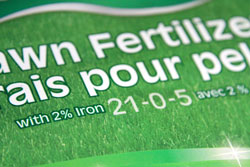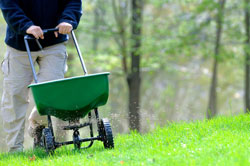I’ve never been much for lawn care beyond mowing and whipper snipping, but this year I’m trying something different. I’m fertilizing, but not in the usual, casual way. Instead of buying whatever bags say “lawn fertilizer” and then spreading the little grey and brown granules with nothing more than hope, I’m getting methodical about the whole process. If I’m going to do the fertilizer thing, I want to do it right. I also want to know for sure if the effort and expense of it all is doing any good. That’s why I’ll be fertilizing half of a chunk of my lawn following all the correct procedures, while leaving the other half as it’s always been. I’ll mow both sections as usual, so any difference should be easy to see. This blog is all about how this works out for me, and how it translates into something you can use at your own home.
I know from science courses I had to take at university that plants need three main nutrients:
- Nitrogen
- Phosphorus
- Potassium
Micronutrients are required too, and I’ll get to that later. But for now, I want to talk about the big three. Usually abbreviated by their chemical symbols N-P-K, the nutrient content of any given fertilizer is printed on the bag or box, in percentage numbers.

The first thing to understand is that soil doesn’t always need fertilizing. Or instance, nobody ever fertilizes the mighty redwood forests on the west coast, and everyone knows how big those trees get. My own lawn was hardwood forest up until 1890, when it was cleared by a pioneer named John Taylor. Old timers still talk about how well the soil grew crops where my kids now play on a swing set. At least those crops grew well for the first few years, anyway.
Trouble is, plant nutrients don’t always stay put, and that’s certainly the case with your lawn. Our habit of mowing, raking, then getting rid of clippings is the main reason why. Every blade of grass that leaves your lawn contains the N, P and K that made it grow lush and green. Then there’s also nutrient loss from the abundant water that many lawns get treated to these days. As more and more lawns are fitted with sprinkler systems, fewer and fewer of them ever know what a dry day feels like. And while this is good for green growth, it also means that more nutrients are being washed out of the soil than ever…a lot more.
West coast redwood forests get tons of rain, but ecosystems like that also have roots going down dozens of feet, compared with just three or four inches for lawns. In the same way that the hay fields my house is built on ran low on natural, nutritional resources several years after cultivation began, your lawn is the same way. In fact, cutting and regularly removing lawn clippings is harder on soil nutrient levels than even the most intensive agricultural practices.

So how’s the soil under your lawn doing in the N-P-K department? It could be feast or famine down there. You’ve got no way of knowing without some analytical insight. This is why soil tests are such a good idea, at least once every few years. But as with many good ideas, this one is routinely overlooked.
I’ve sent soil samples away for testing from my vegetable garden and prized lilac hedge over the years, but never before from my lawn. Various services offer lawn soil nutrient analysis, and these provide a great starting point. It’s becoming more and more necessary that we manage and apply nutrients responsibly, and knowing what you’ve got is a necessary starting point.
As it turns out, my lawn is quite low in potassium – the last number in the big three numerical trio. The sample results don’t include any measurement of the nitrogen levels in the soil, and neither do every other soil test on the planet. Why the missing nitrogen? What’s the best way to correct a nutrient deficiency, potassium or otherwise? That’s what you’ll find out in my next lawn care blog.
To learn more about fertilizing with the Right Source at the Right Rate, Right Time and Right Place, visit www.greenerworld.ca.